
DR.
J'S ILLUSTRATED LECTURES
The
Illustrated Mythic Hero
Illustrated Greek Theater
Illustrated Greek Drama
Illustrated Parthenon Marbles
Illustrated Road to the Recovery of
Ancient Buildings
Illustrated Greek History MENU
Bronze Age
Archaic Age
Persian Wars
Classical Age
|
 |
Dr.
J's Illustrated Archaic Age
color-coded
Timeline/Lecture
war
literature/theater
politics
science/philosophy
Panhellenic
Festivals
It
turned out to be more difficult than I thought to assign colors to
various aspects of Greek history. And this speaks to the very nature of
ancient Greek culture: spheres of influence were not so easily divisible
in ancient Greece as they are for us. The Greeks had an uncanny facility
to move easily from the sacred sphere to the political to the
domestic... it makes me mourn the loss of that totality of experience in
our own culture. Back then, kings consulted religious Oracles on matters
of State, athletes at Panhellenic Games sought glory for their home
cities from the particular Olympic god to whom the games were dedicated,
and the God Dionysus himself - in the figure of his cult statue -
presided over theatrical competitions in fifth century Athens. Is Attic
theater an artistic invention? A political tool? A religious event? All
of the above. How can we define "philosopher"? The cosmologist
Pythagoras attracts a religious following; Socrates becomes a political
subversive; Aristotle invents literary theory. What an amazing time, and
what amazing people.
The
Archaic Age is characterized by a Greek spirit of unity not quite strong
enough to unite the cities politically, but definitely strong enough to
remind them of their common bond. This busy time has been described as
The Age of Aristocracies, The Age of Expansion, The Beginning of the
Western Literary Tradition, and the Age of Law-Givers. The first thing
we notice is that there are no really big wars in this age, and people
are busy developing culture: Panhellenic
Festivals, theater,
law codes, literature,
democracy,
and early
Greek science and philosophy
all hark back to the Archaic Age.
|
Age
of Aristocracies
|
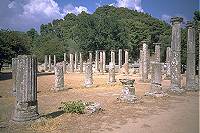 The
Archaic Age is best known as the Age of Aristocracies, because
its developing poleis (city-states) are
characterized by a rejection of the old-style monarchies of
the Mycenean Age (as
dramatized in later plays you may have read such as Aeschylus'
Agamemnon and Sophocles' Oedipus).
The
Archaic Age is also characterized by the development of
Panhellenic Centers, one of the first signs that Greece is
coming out of the previous period, known as the Dark Age. The
destruction of Mycenean civilization caused a fearful time in
which the Greeks of each area kept to themselves (which is
very easy to do in Greece since the mountainous topography
naturally isolates each habitable area from the next). The
establishment of the Panhellenic ("All-Greece")
Festival at Olympia (in honor Zeus) is the first sign that
Greeks are beginning to communicate and interact with each
other again. They came from all over to compete for the honor
of their home city-state. OLYMPIA
is a city in the Peloponnesus (southern part of Greece), named
in honor of Zeus, King of the Olympian gods; don't confuse it
with MT.
OLYMPOS, the mountain home to the OLYMPIAN gods. On the
left is a photo of the Palaestra at Olympia, where the
athletes practiced, although the ancient
competitions were not restricted to athletic events, as
they are today.
The
Archaic Age is best known as the Age of Aristocracies, because
its developing poleis (city-states) are
characterized by a rejection of the old-style monarchies of
the Mycenean Age (as
dramatized in later plays you may have read such as Aeschylus'
Agamemnon and Sophocles' Oedipus).
The
Archaic Age is also characterized by the development of
Panhellenic Centers, one of the first signs that Greece is
coming out of the previous period, known as the Dark Age. The
destruction of Mycenean civilization caused a fearful time in
which the Greeks of each area kept to themselves (which is
very easy to do in Greece since the mountainous topography
naturally isolates each habitable area from the next). The
establishment of the Panhellenic ("All-Greece")
Festival at Olympia (in honor Zeus) is the first sign that
Greeks are beginning to communicate and interact with each
other again. They came from all over to compete for the honor
of their home city-state. OLYMPIA
is a city in the Peloponnesus (southern part of Greece), named
in honor of Zeus, King of the Olympian gods; don't confuse it
with MT.
OLYMPOS, the mountain home to the OLYMPIAN gods. On the
left is a photo of the Palaestra at Olympia, where the
athletes practiced, although the ancient
competitions were not restricted to athletic events, as
they are today.
|
|
Age
of Expansion: 750-550 B.C.
|
| From
750-550 B.C., Greek civilization revitalized. In response to
rapid population growth and a lack of arable land (grapes and
olives are about the only crops that thrive), a new
breed of Greeks sets out to discover or forge a new world.
Colonists ranged far and wide, east to the Ionian Coast of
Asia Minor, South to the northern shores of Africa, and west
to Europe: Marseilles was originally a Greek colony, and
Sicily and southern Italy has so many settlements on it it was
known as Magna Graecia, or "Big Greece." Many
of these settlements opened trade routes for Greece that
helped them become a world player in the centuries to come.
(Temple students, see your map on page 12 of your IH Source
Book - all the shaded areas are colonies dating to this
period.)
The
photos above (well, they will be soon!) are of Paestum
(originally called Poseidonia) in Italy, a Greek colony
founded by Greeks from Achaea (mid-Peloponessus) in honor of
the god of the sea, Poseidon. These are some of the most
breathtaking archaic temples that exist today. On the left, a
temple to Hera, on the right, one to Demeter, and the temple
in the middle - under the tent - is dedicated to Poseidon.
|
|
The
Western Literary Tradition begins with poetry
|
| The
Western literary tradition begins with the works of Homer and
Hesiod, dating to the mid 8th century B.C. The epic poet Homer
codified and wrote down the stories of the Trojan War (in his
Iliad and Odyssey) told orally for hundreds of years since the
actual war was fought (ca. 1250 B.C.). The didactic poetry of
Hesiod (author of Theogony and Works and Days) links everyday
life (especially for farmers) with the world of the
gods. Both authors are throwbacks to an earlier time, the
long-lost Mycenean Age (Bronze Age) when gods and man walked
the earth together (thank you, Xena...) and all Greeks were a
unified force and a more homogenous culture (i.e., it was all
Greeks against a common outside enemy, the Trojans, back then,
not one Greek against Greek another).
But
the Archaic Age, on the other hand, is witness to the
development of individually distinguishable city-states. And
it is this strain of individuality and self-expression that
paves the way for the next literary development, the lyric
poem. The lyric poets flourished in the newly colonized Asia
Minor shoreline and islands in the late 7th century B.C. (the
lower 600's B.C.). Sappho's birthdate, for example, is
estimated at ca. 610 B.C. Greek lyric poetry offers an
alternative to Homer's epic or Hesiod's didactic poetry. While
epic poetry reflects the totality of a culture, lyric poetry
is more concerned with communicating personal sentiment -
feelings of love, grief, friendship, etc. The lyric poetry of
Sappho and the other famed eight lyric poets of her age
provides a personal voice new to Greek literature and imitated
by generations of poets thereafter.
|
|
Age
of Law-Givers 621 - 594 B.C.
|
| The
last half of the 7th century B.C. is known as the Age of
Law-Givers in Greece. Draco's Law Code in Athens in 621 B.C.
caused tradition and custom to become written law for the
first time. This is a photo of the Law Code of Gortyn (SOON!),
in Crete, but Draco's Law also would have been similarly
carved into stone and publicly displayed. Draco's Code was
considered harsh, but his goal was to lessen the discrepancy
between the haves and the have-nots, economically speaking.
But despite Draco's attempts, poor people still suffered at
the hands of unscrupulous land-owners and people had gripes.
Often there were spontaneous revolts by the underprivileged
classes who could no longer bear the burden of their place in
society. The stage was set for some serious reform.
Enter
Solon the Law-Giver in 594 B.C. Solon, one of the proverbial
Seven Ancient Sages, did not hail from Athens, or even from
mainland Greece. He was one of the traveling wise men who
learned lessons from the way varied cultures handled their
challenges. Solon was given the power to re-distribute the
wealth across the board, providing welcome opportunities for
society's have-nots. Many farmers did not own the land they
worked in the first place, or they accrued debts they couldn't
pay and became sharecroppers as a result. Solon cancelled or
reduced debts and redistributed the land, restoring property
to many. Solon encouraged the production and export of olive
oil, lured foreign craftsmen with the promise of citizenship,
and made it a law that all fathers should teach their son a
trade. The Athenian pottery business grew from this edict, and
it explains why Athenian pots are found all over the
Mediterranean and beyond. Solon single-handedly created a
merchant class. He also created the first citizen-manned
courts, giving the people valuable experience in
self-government.
|
|
Age
of Tyrants in Athens: 561 - 510 B.C.
|
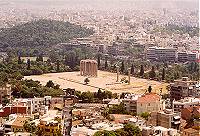 Pesistratus
becomes Tyrant of Athens. Back then, "tyrant" just
meant something like "the buck starts and stops
here" - he was the sole ruling body in the land, an
aristocrat's aristocrat - not necessarily a cruel and
megalomaniac ruler. Although totalitarian about making laws,
Pesistratus did have Athens' interest at heart. Under his
rule, the city prospered: he built an aqueduct, redistributed
confiscated land, helped poor farmers. Characteristic of
tyrannical rule is the desire to build monumental edifices,
proofs of the tyrant's power. The Temple
of Olympian Zeus, right, was designed to be the largest
temple in Greece (remember - the Parthenon
won't be built until 447, over 100 years later). But
Pesistratus didn't finish it; the Roman Emperor Hadrian did
- 700 years later! Pesistratus rules until 528 B.C., when his
sons Hippias and Hipparchus take over. Pesistratus
becomes Tyrant of Athens. Back then, "tyrant" just
meant something like "the buck starts and stops
here" - he was the sole ruling body in the land, an
aristocrat's aristocrat - not necessarily a cruel and
megalomaniac ruler. Although totalitarian about making laws,
Pesistratus did have Athens' interest at heart. Under his
rule, the city prospered: he built an aqueduct, redistributed
confiscated land, helped poor farmers. Characteristic of
tyrannical rule is the desire to build monumental edifices,
proofs of the tyrant's power. The Temple
of Olympian Zeus, right, was designed to be the largest
temple in Greece (remember - the Parthenon
won't be built until 447, over 100 years later). But
Pesistratus didn't finish it; the Roman Emperor Hadrian did
- 700 years later! Pesistratus rules until 528 B.C., when his
sons Hippias and Hipparchus take over. |
|
The
Institution of the Theater 534 B.C.
|
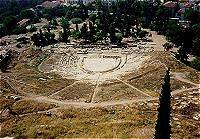 One
of Pesistratus' accomplishments was to found the institution
of the theater in Athens. Thespis wins the the 1st competition
of the new Great Dionysia Festival at Athens, featuring public
productions of tragic drama in honor of the god Dionysus, in
an early version of this theater (right) on the south slope of
the Acropolis. Around this time the tradition of publicly
reciting Homer at the Panathenaic Festival began, too. This
was the beginning of democratic idealism: making culture
available to everyone, instead of just a few. The Pesistratid
tyranny will last only another 25 years or so, and then
democracy will take hold in Athens. But the cultural
institutions he founded lived on. One
of Pesistratus' accomplishments was to found the institution
of the theater in Athens. Thespis wins the the 1st competition
of the new Great Dionysia Festival at Athens, featuring public
productions of tragic drama in honor of the god Dionysus, in
an early version of this theater (right) on the south slope of
the Acropolis. Around this time the tradition of publicly
reciting Homer at the Panathenaic Festival began, too. This
was the beginning of democratic idealism: making culture
available to everyone, instead of just a few. The Pesistratid
tyranny will last only another 25 years or so, and then
democracy will take hold in Athens. But the cultural
institutions he founded lived on. |
|
The
Beginnings of Democracy 510 B.C.
|
In
510, Cleisthenes takes power - after the assassinations of
Hippias and Hipparchus - and completely reforms the Athenian
constitution, diluting the power of the aristocracy. His
reforms establish the Council of the 500, the Board of
Strategoi (Ten Generals), and a popular court system replaces
the aristocratically-run Council of the Areopagus,
which continues to preside only over murder cases. Cleisthenes
accomplishes all of this by drawing on both the Greek love of
competition (as seen in the Olympics and in the theater
contests), and on their equally strong love of individuality.
He artificially creates new tribes (replacing the old
aristocratic tribal loyalties) which are composed of
inhabitants of various demes (territorial divisions). Each
tribe has members drawn from demes from three different
regions - inland, coast and city. So these new
"teams" (think "color-war") are all equal
in their diversity, since each one has constituents from all
over - no one slice of society (city merchants, sailors,
farmers) has more say than another. This is a brilliant
stroke: each deme retains control over its own local affairs,
and each deme contributes adult male citizens to the Assembly,
the new democratic ruling body of Athens.
Any public structure carries the mark of the deme (DHMOS),
and I was tickled to find evidence of this even in the
municipalities of modern Greece. Here are two garbage cans,
one in Athens
(AQHNAIWN)
and the other in Pylos
(PULOU),
which clearly show the cities' pride in public works: |
|
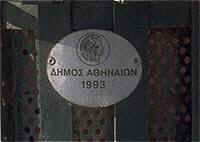
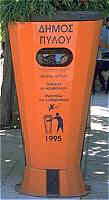
|
| At
the end of the 6th century B.C., Athens is in perfect position
for her next move: the progression has advanced from the
hereditary monarchy in the Bronze Age to the development of
aristocratically-run poleis in the Archaic Age. Soon will come
the Age of Democracy - the Golden Age of Athens - a fifty-year
window of opportunity that closes all too soon during the Classical
Age. But first, Greece must survive the Persian
Wars... |
|
|

 The
Archaic Age is best known as the Age of Aristocracies, because
its developing poleis (city-states) are
characterized by a rejection of the old-style monarchies of
the Mycenean Age (as
dramatized in later plays you may have read such as Aeschylus'
Agamemnon and Sophocles' Oedipus).
The
Archaic Age is also characterized by the development of
Panhellenic Centers, one of the first signs that Greece is
coming out of the previous period, known as the Dark Age. The
destruction of Mycenean civilization caused a fearful time in
which the Greeks of each area kept to themselves (which is
very easy to do in Greece since the mountainous topography
naturally isolates each habitable area from the next). The
establishment of the Panhellenic ("All-Greece")
Festival at Olympia (in honor Zeus) is the first sign that
Greeks are beginning to communicate and interact with each
other again. They came from all over to compete for the honor
of their home city-state.
The
Archaic Age is best known as the Age of Aristocracies, because
its developing poleis (city-states) are
characterized by a rejection of the old-style monarchies of
the Mycenean Age (as
dramatized in later plays you may have read such as Aeschylus'
Agamemnon and Sophocles' Oedipus).
The
Archaic Age is also characterized by the development of
Panhellenic Centers, one of the first signs that Greece is
coming out of the previous period, known as the Dark Age. The
destruction of Mycenean civilization caused a fearful time in
which the Greeks of each area kept to themselves (which is
very easy to do in Greece since the mountainous topography
naturally isolates each habitable area from the next). The
establishment of the Panhellenic ("All-Greece")
Festival at Olympia (in honor Zeus) is the first sign that
Greeks are beginning to communicate and interact with each
other again. They came from all over to compete for the honor
of their home city-state. 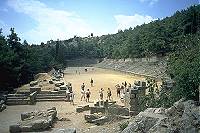
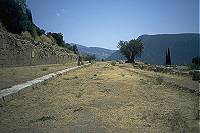

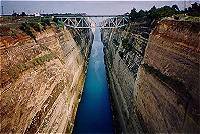 about a decade later (560's B.C.) the Isthmian Games
are founded (honoring Poseidon at Isthmia). "Isthmia"
is where we get the word "isthmus" -
this is the city on the bridge of land that joins
the southern land-mass of Greece, the Peloponnesus,
with Sterea Ellada, or Central Greece. Today, ships
can sail right through the Corinth Canal (photo on
right), but in antiquity, boats had to be dragged
across a mile-wide strip of land called the Diolkos
if they didn't want to have to sail all the way
around the southernmost tip of Greece.
about a decade later (560's B.C.) the Isthmian Games
are founded (honoring Poseidon at Isthmia). "Isthmia"
is where we get the word "isthmus" -
this is the city on the bridge of land that joins
the southern land-mass of Greece, the Peloponnesus,
with Sterea Ellada, or Central Greece. Today, ships
can sail right through the Corinth Canal (photo on
right), but in antiquity, boats had to be dragged
across a mile-wide strip of land called the Diolkos
if they didn't want to have to sail all the way
around the southernmost tip of Greece.


